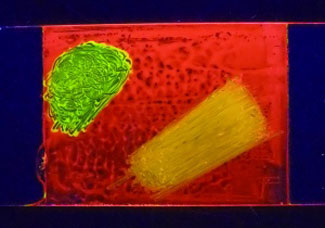| Dec 05, 2011 |
Various stimuli causes a single luminescent liquid-crystalline material to emit three different colors
|
|
(Nanowerk News) Materials that change color in response to an external stimulus such as a change in temperature are of great interest because they can be used in information displays, memory devices and sensors among many other applications. Liquid-crystalline materials are widely used as the stimuli-responsive media in such devices because relatively small changes in external conditions can have a large effect on the molecular packing of the liquid crystal. Yoshimitsu Sagara and Takashi Kato from the University of Tokyo in Japan have now developed a photoluminescent liquid-crystalline material that can switch between three colors in response to both mechanical and thermal stimuli ("Brightly Tricolored Mechanochromic Luminescence from a Single-Luminophore Liquid Crystal: Reversible Writing and Erasing of Images").
|
 |
| A thin film of a liquid-crystalline material displaying three different colors in response to two different stimuli.
|
|
The molecules in liquid crystal are arranged in a state that is intermediate between a liquid and a solid, with crystal-like order on short length scales but disorder on longer scales. Changes in color in these materials can be produced by changing how the molecules are packed together. In the past, however, liquid crystals have only been engineered to respond to a single stimulus, and usually only to switch between two states.
|
|
The material developed by Sagara and Kato, on the other hand, is both mechanochromic and thermochromic, changing color in response to both mechanical and thermal stimuli. "The dumbbell-shaped molecules of our liquid crystal system pack together in three different ways," explains Kato. "The three arrangements are all stable at room temperature once formed, but combinations of heating and mechanical shearing produce the different colors."
|
|
When initially deposited as a thin film, the material emits red light (see image). Heating to 90 °C and applying a shearing force produces a green phase, which is more energetically stable. Both the red- and green-emitting phases can be transformed to a yellow-emitting phase by applying a shearing force without heating. Similarly, both the green- and yellow-emitting phases can be switched back to the red phase by heating to the higher temperature of 145 °C and subsequently cooling.
|
|
The ability to produce three colors from a single-component device might ultimately lead to cheaper and easier-to-produce luminescent displays. "We are working on the design of new liquid-crystalline luminescent materials for new types of displays and sensors," says Kato.
|

